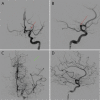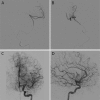Acute middle cerebral artery stroke in a patient with a patent middle cerebral artery
- PMID: 31341713
- PMCID: PMC6615667
- DOI: 10.1212/CPJ.0000000000000605
Acute middle cerebral artery stroke in a patient with a patent middle cerebral artery
Abstract
Purpose of review: Knowledge of cerebrovascular anatomical variants is vital for clinicians working with patients presenting with signs and symptoms of cerebral infarction, particularly in the era of endovascular clot retrieval.
Recent findings: We provide an overview of a cerebrovascular anatomical variation and detail a patient presenting with cerebral infarction secondary to occlusion of their anomalous vessel who underwent successful endovascular clot retrieval with excellent functional outcome. We also include technical descriptions.
Summary: Given the clinical importance of the areas supplied by the accessory middle cerebral artery, knowledge of this vessel is not only important for diagnosis but also for neurosurgical or endovascular management of patients with this variant.
Figures




Comment in
-
Vascular variants and the evaluation of patients with acute stroke.Neurol Clin Pract. 2019 Jun;9(3):185-186. doi: 10.1212/CPJ.0000000000000635. Neurol Clin Pract. 2019. PMID: 31342959 Free PMC article. No abstract available.
References
-
- Crompton MR. The pathology of ruptured middle-cerebral aneurysms with special reference to the differences between the sexes. Lancet 1962;2:421–425. - PubMed
-
- Abanou A, Lasjaunias P, Manelfe C, Lopez-Ibor L. The accessory middle cerebral artery (AMCA): diagnostic and therapeutic consequences. Anat Clin 1984;6:305–309. - PubMed
-
- Marinkovic S, Milisavljevic M, Kovacevic M. Anatomical bases for surgical approach to the initial segment of the anterior cerebral artery: microanatomy of Heubner's artery and perforating branches of the anterior cerebral artery. Surg Radiol Anat 1986;8:7–18. - PubMed
Publication types
LinkOut - more resources
Full Text Sources
Research Materials
